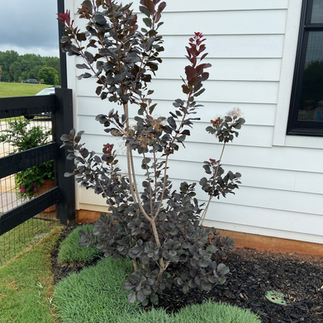Mastering Gardens
- Peggy Jones

- Jul 1, 2022
- 4 min read
One of the best things about becoming a Master Gardener is visiting other gardens! Today we had the pleasure of visiting the gardens of Janet and Jim Bones in Social Circle. Not only was it gorgeous and buzzing with pollinators, but we had to constantly remind ourselves that it all started from a blank slate a mere three years ago when they moved here from Minnesota. I don’t know about you, but coming up with a plan is the hardest part…then deciding what to plant when you don’t have a clue about what grows here...and that's not even mentioning our beautiful red Georgia clay soil. Well, you get the drift!
Janet is quick to say that her garden is always evolving. The more she learns, the more she sees her garden evolve. As President of the Walton County Master Gardeners, she works in partnership with the Walton County UGA Cooperative Extension to facilitate, expand and direct garden-based educational outreach with our Master Gardeners by assisting with garden projects, teaching classes and workshops, working in community and historic gardens, providing information at public events and media outlets, and answering gardening questions through the UGA Extension Help Desk. Through her leadership, we have implemented a website, social media platforms and blog, and established a strong foundation for future growth and communication. She was instrumental in getting the Social Circle Pollinator Garden established in Friendship Park and has slowly changed her focus in her own garden to pollinators and native plants.
Grab your trowels and let's get started.
The first thing we noticed is her vegetable garden and shed. She has fenced it in to keep out the deer and everything is green and vibrant. We will have to visit in a couple of weeks when all her tomatoes come in.
Behind that is her chicken coop. She has 12 chickens and one guinea hen and they lay about 8 eggs a day. She has named them all – Opal, Pearl, Ruby, Topaz, Calais, Mandy, Sky, Charlotte, Betty, Ethyl, Iris, and Big Bird.
We then visited her pollinator garden. Establishing a foundation in her garden is key. One of the tips she shared with us is how she planned out this bed. Roughly 10 feet deep and 80 feet long, she covered the Bermuda with a layer of cardboard and watered it well this past fall. They covered the cardboard with about 4 inches of high-quality compost, and then let nature do the work by letting it sit for 6 months. The Bones' purchased their compost from Master Landscape Supply in Covington and had it delivered in bulk. When spring came, they lightly tilled and were amazed at the transformation of their clay soil. Does this technique get rid of Bermuda completely? ALMOST! It is a lot simpler and less backbreaking than digging out large beds of Bermuda. Not to mention the positive impact the process has on the soil. Try it for yourself! We would love to hear how it does for you.
The pollinator garden was alive and buzzing with bees, butterflies and hummingbirds and was just delightful! Filled with Mexican Sunflower, Zinnias, Cosmos, Coneflower, Milkweed, Butterfly Weed, Blazing Star Liatris, Prairie Coneflower and Blanket Flower, it was fun to see (and hear) all the activity. The deer are frequent unwelcome guests, grazing happily on new succulent growth. It is always a struggle to keep them away and everyone had their own tips and suggestions. Probably the best and wisest was to take it all in stride and plant an extra row for the deer! Janet also incorporated native shrubs in her pollinator border, including Winterberry and a new cultivar of Beautyberry called Pearl Glam which grows just 5 feet tall and sports purple tinted leaves in addition to the gorgeous orchid-colored fruits in late summer.
Entering the fenced in back yard through a trellis covered in Confederate Jasmine vine was a delight. It was fun hearing where each plant came from and she tags each one to remember the name and varietal with plant tags and stakes. Serviceberry is a native tree she highlighted that has 3-season interest, beautiful white flowers in the spring, followed by blue drupes loved by the birds, and nice fall color.
Blueberries are ripe for the picking, and the fig trees are loaded. The Crepe Myrtles should be in full bloom soon. Something is always in bloom in her garden.
Stokes asters and Baptisia make a nice combination. Moonbeam coreopsis is light and airy and a David Austin rose is being trained to climb. Finally German Irises (Janet’s favorite) pepper all her beds! Their spikey blue-gray upright blades always add architectural interest even when not in bloom!
There is so much to see and catch the eye - A pretty baker's rack of succulents, a planter with a Japanese maple, Smoke tree on the side of the house, a pretty little planter with a pencil holly, and David Austin rose - We loved this iron planter filled with succulents hanging on the fence.

This sign says it all.


Thank you, Janet and Jim Bones, for letting us visit your beautiful garden in Social Circle! We love your passion for gardening, and can't wait to see what new plants you add.
What garden will we visit next? We shall see. We hope you will join us on our journey of Mastering Gardens. We hope to visit, to share, to discover, and to learn from each other. Some of our gardens are in the planning stages, some have been established for many years, and some are in between but what matters is the joy we get when we see the hummingbirds, hear the honey bees, smell the flowers, touch the velvet leaves, and taste the fruits and vegetables.
“The glory of gardening: hands in the dirt, head in the sun, heart with nature. To nurture a garden is to feed not just the body, but the soul.” Alfred Austin


















































Thanks so much for sharing the article about leafminers. My oak tree leaves look just like the one in the picture and I didn't know why.